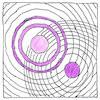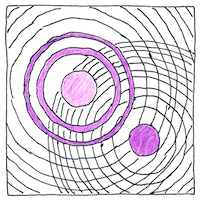Dennis Gabor
optics

|
Holography
Dennis Gabor created the hologram to correct the spherical abberation of the electron microscope. A photograph records the frequencies and intensities of normal light scattered in one direction from a scene. A hologram records the interference pattern of coherent light reflected from a scene in multiple directions so that diffraction of the original light source can recreate a field of light reflected in the same direction as light from the original scene.
Full spectrum
The first holograms were monochromatic. Dennis Gabor used a mercury lamp through a pinhole to record holograms one centimeter in diameter. Today, holograms can be made in full color using red, yellow, and cyan lasers, or by increasing the depth of the recording media and relying on Bragg defraction to select colors. Rainbow holograms are visible under normal light but sacrifice vertical or horizontal parallax. Pulsed lasers and phase congugation permit recording and reconstruction of moving holograms. Holograms can also be generated by computer so as not to require any light in their making. Holographs can be used for general data storage and for measuring surface irregularities, vibrations, swiftly moving objects, and fluid flows.
Half a hologram
Half a hologram records all the image but with more noise. Dennis Gabor said the human memory could be holographic. Lose half of it due to age or illness and the memories are still there with less clarity, less confidence, less speed of recall.



A holograph relies on the wave nature of light. It captures the interference pattern, where half of a split laser beam reflects off a scene and the other half, called the reference beam, bypasses the scene to interfere with the reflected light. To reconstruct the light from the scene, illuminate the hologram with a beam that is identical to the reference beam.
See also in The book of science:
Readings in wikipedia: